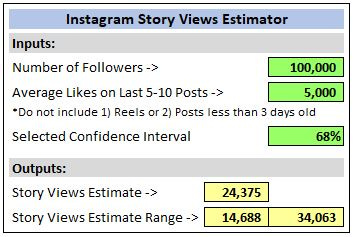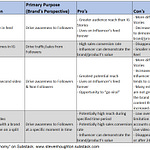Happy Wednesday!
It’s another great day! Whether you’re reading this at home, in the office, or are just listening on your drive, buckle up because your day is about to get even better :)
If you recall, we left off last week with the understanding that:
The Influencer business (Brand Collabs) is basically a scaled down version of the Network TV business.
The formula to quantify that is: [Annual Influencer Collab Profit] = [Avg Number of Viewers] x [Avg Viewer] x [Avg Number of Collabs per Week] x [Number of Weeks Worked per Year]
Which simplified is [Influencer Profit] = [# IG Story Views] x [CPM]
If any of that is not crystal clear in your memory, I recommend reviewing last weeks newsletter.
Okay, so now that we are all on the same page, let’s review a concrete example:
Influencer: @notrealinfluenceraccount
Key Stats:
200k followers
70% USA based, Mostly women aged 18-49
Avg Story Views: 30,000
Avg CPM: $60
Avg # Collabs per week: 2
# Weeks Worked per year: 50
How much money would @notrealinfluenceraccount make in a year?
30,000 Story Views x $60 CPM = $1,800 per collab.
At 2 collabs per week and 50 weeks worked per year, @notrealinfluenceraccount would make $180,000 per year.
Commonly asked Questions I get when I explain this to someone in-person:
Q: “Are you kidding me?”
A: Nope!
Q: “How do you know what an Influencer’s CPM is?”
A: If they are with an agency, and they have a “high value” audience, you can often assume a $50-80 CPM. I’ve seen some command a CPM upwards of $150, but that is rare. If the Influencer is new, uninformed about pricing, or doesn’t convert, their CPM may be in the $10-40 range.
Q:“Wait a minute… Does this mean Influencer XYZ, who has 1 million followers, makes 5x that?
A: Maybe. It largely depends on their story views, CPM, and the number of collabs they do. It’s entirely possible they make 20x that. It’s a also possible they make less than that.
Q: “How do you estimate an Influencer’s story views?
A: There are 2 ways:
Use my Story View Estimator
Ask the Influencer
1st Way: Story View Estimator
The Story View Estimator is something I created to get quick back-of-the-envelope estimates for Influencer’s story views. I mostly use it in concert with a few other tools, when I’m considering a new Influencer-driven business model or product. That said, it can also be used as a standalone tool. All you do is enter the 2 pieces of data it requires (both publicly available on most IG accounts) into the green cells, select your “confidence interval” in the dropdown, and bada bing bada-boom, you have your estimate and your estimate range for an Influencer’s IG story views.
Screenshot example:
*Please note: In my experience, the Story View Estimator is best used to get a general idea, not an exact figure. That said, it is sometimes shockingly accurate. Feel free to download my Estimator and play around with it :)
2nd Way: Ask the Influencer
Okay, so what I don’t mean here is to DM the Influencer and say, “Hi, what are your story views?” That would be quite nearly as rude as asking “Hi, how much money do you make?” However, if you are a brand looking to partner with Influencers, it is absolutely appropriate and completely normal to request a “media kit”. Every Influencer has some version of a media kit that includes a lot of statistics about their account(s), including average story views.
Putting It All Together
Well there you have it! You are now equipped with 1) the formula and 2) the means of using the formula, to estimate Influencer Brand Collaboration earnings. Any questions?
Give yourself a big pat on the back because you probably now know more about the Influencer economy than you did 10 minutes ago, AND you definitely know more than 99% of the world. Good job :)
The Catch
Remember in last week’s newsletter how we learned:
Well, it’s almost time to learn about that “one very important difference”… But not until next week because I’ve got to keep things interesting :) And because Stevie Kate (my daughter) just woke up from her nap and I’m on princess duty!
Before I leave though, a few quick anecdotes I promised to answer from last week!
Why do restaurants rarely work with Influencers?
Answer: 2 reasons:
Influencers tend to reach geographically diverse communities. There aren’t many people who will fly across the country, let alone drive over 20 minutes on a typical Wednesday, to try out a new restaurant, no matter how much their favorite Influencer recommends it. Turtle Creek Lane for example has over 600k followers across the USA. Less than 2% live close enough to reasonably be expected to go to a restaurant she recommends. So 98% of followers would be exposed to a product/service that is not even reasonably accessible to them. Not a good collab for either party.
Restaurants are typically low margin businesses. Successful influencer marketing campaigns tend to revolve around higher margin businesses and products.
Why are there no Yale Influencers?
Answer: What this is really getting at is, “why are there so few Influencers from Ivy League schools?” We can’t know for sure, but here are 3 potential reasons:
The most successful Instagram Influencer’s tend to be aspirational, not inspirational. If you’ve already turned 12, you’re too late; Yale is out of reach. You needed to start preparing at 4 if you wanted a chance at Yale’s East Asian Studies Degree. Thus, it stands to reason that aspiring Yale Influencers need to target the 4 and below audience if they hope to reach the critical scale necessary to run profitable brand collaborations. ***This is a joke, but the Aspiration vs Inspiration point is serious. People want to follow Influencers who are relatable on at least one important dimension.
The smartest people1 tend to be both risk adverse and highly memetic. These traits often lead them to careers in Banking, Medicine, and Law. In the previous generation, working at Goldman or McKinsey was seen by many as the ideal. This may be changing. 2020 was the first year the broader public began recognizing the value and power of media-first business models. As the Influencer/Creator economy becomes more widely understood, I suspect we may see more and more Ivy League educated influencers.2
Good luck convincing a young Influencer they need to go to Yale to be successful.3
Well that’s all for now!
Let me know in the comments if you have any questions, or if there are any specific topics you’d like me to cover!
Best,
Steven jr
I define “smart” in this context as someone who would score high on both an IQ test and a conscientiousness test.
Fun fact, the person I sat across from during my 3 years at Goldman Sachs also left Wall Street to work in the Influencer space and build media-first businesses. For those of you who watch The Bachelor, you might recognize him: Connor Saeli (the tall guy from Hannah Brown’s season). Everyone in the office thought it was some kind of joke when he left Goldman to be on The Bachelor. Best said by another person, “Who the **** leaves here to be on some reality TV show for a season?” There are 2 possible answers in my mind.
Someone who realizes he could get nearly half a million followers on Instagram, and knows how to do a CAC vs LTV analysis (this is a common form of financial analysis where a prospective investor analyzes the difference between 1. how much it costs a company to acquire a customer and 2. how much that customer is worth).
A hopeless romantic who rocks out to J Biebs, once shyly admitted to loving the Netflix Original, The Kissing Booth, and is looking for love.
I’ll let you decide :)
Ask any girl under 22 “Would you rather be one of the McKnight twins, or have a degree from Harvard?” (for context, Brooklyn and Bailey McKnight are 22 year old twins with millions of social media followers). Good luck finding anyone who’d rather have the Harvard degree.









Share this post